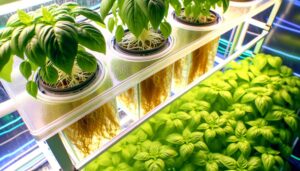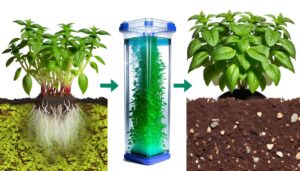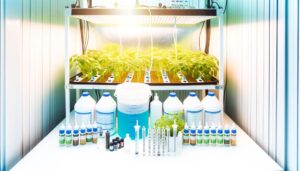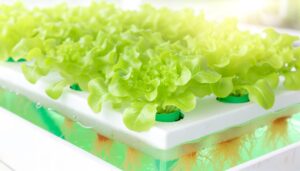Find Out What Defines Organic in General Hydroponics Nutrients Here
General Hydroponics’ nutrient solutions primarily fall under synthetic formulations designed for high solubility and efficient nutrient uptake in hydroponic systems. Synthetic nutrients, such as those in the Flora Series, provide precise macro- and micronutrient ratios essential for plant growth.
While these solutions optimize plant health and productivity, they do not meet organic certification standards, which require nutrients to be derived from natural sources and minimally processed.
If you’re interested in exploring the detailed distinctions between synthetic and organic nutrients, along with their implications on plant health and environmental sustainability, further information is available.

Key Takeaways
- General Hydroponics offers both synthetic and organic nutrient solutions, catering to diverse cultivation needs.
- The BioThrive product line by General Hydroponics is specifically designed to meet organic farming standards.
- Organic certification involves rigorous compliance with USDA or OMRI guidelines, which some General Hydroponics products meet.
- Not all General Hydroponics nutrients are organic; verify product labels for organic certification and compliance.
General Hydroponics Nutrients – Organic or Not?
| Nutrient Type | Organic Status | Description |
|---|---|---|
| General Hydroponics FloraGro | Not Organic | Synthetic nutrients designed for plant growth in hydroponics. |
| General Hydroponics FloraBloom | Not Organic | Boosts flower and fruit production with mineral-based formula. |
| General Hydroponics FloraMicro | Not Organic | Provides essential micronutrients for plants but made with synthetic compounds. |
| General Organics Go Box | Organic Certified | A set of organic nutrients from General Hydroponics designed for hydroponic use. |
| General Hydroponics BioThrive | Organic Certified | Promotes healthy growth through organic, plant-derived ingredients. |
Understanding Hydroponic Nutrients
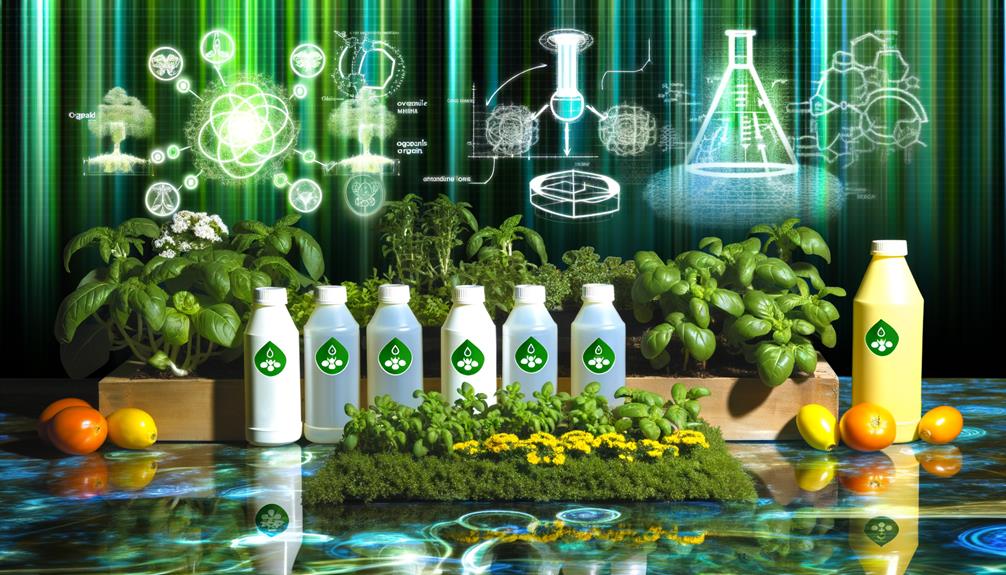
Hydroponic nutrients are specifically formulated solutions that provide essential macro and micronutrients to plants grown in soilless systems, ensuring ideal growth and development.
These nutrient solutions typically contain nitrogen (N), phosphorus (P), and potassium (K) as primary macronutrients, along with secondary macronutrients such as calcium (Ca), magnesium (Mg), and sulfur (S).
Additionally, they are enriched with micronutrients like iron (Fe), manganese (Mn), zinc (Zn), copper (Cu), molybdenum (Mo), and boron (B), which are vital for various physiological and biochemical plant processes.
The precise balance and solubility of these nutrients are critical for optimizing nutrient uptake and plant health.
Hydroponic systems often utilize these solutions to achieve controlled and consistent nutrient delivery, thereby maximizing yield and quality.
What Defines Organic Nutrients
Organic nutrients are derived from natural sources and are minimally processed to retain their biological integrity, thereby providing plants with essential elements in a form that promotes sustainable growth and soil health.
These nutrients are typically obtained through the decomposition of plant and animal matter, guaranteeing the presence of complex compounds that are beneficial for plant metabolism.
Key characteristics of organic nutrients include:
- Biodegradability: Organic nutrients decompose naturally, enhancing soil fertility.
- Microbial Activity: They support beneficial microbial populations which play an essential role in nutrient cycling.
These properties make organic nutrients fundamental to eco-friendly agricultural practices, contributing to both plant health and environmental sustainability.
General Hydroponics Product Line

The General Hydroponics product line encompasses a diverse array of nutrient solutions and supplements meticulously formulated to support ideal plant growth in hydroponic systems.
Core offerings include the Flora Series, a three-part nutrient system designed to deliver essential macro and micronutrients.
Additional products, such as the Maxi Series and BioThrive, cater to various growth stages and specific plant requirements.
Supplements like Armor Si and CALiMAGic enhance nutrient uptake and structural integrity.
General Hydroponics also provides pH management solutions like pH Up and pH Down, ensuring peak nutrient solubility and availability.
Each product aims to maximize yield, quality, and overall plant health, reinforcing their standing within the hydroponics community.
Ingredients Breakdown
The composition of General Hydroponics’ organic nutrients includes key components such as nitrogen, phosphorus, and potassium, derived from naturally sourced materials.
The source of these ingredients ranges from mineral deposits to plant and animal by-products, ensuring a balanced and sustainable nutrient profile.
Understanding the origin and function of each nutrient is critical for optimizing plant growth and health in hydroponic systems.
Key Nutrient Components
A thorough analysis of General Hydroponics nutrients reveals a meticulously balanced composition of essential macro and micronutrients designed to optimize plant growth and health. These nutrients are formulated to deliver precise proportions of nitrogen, phosphorus, and potassium, along with other critical elements such as calcium, magnesium, and trace minerals.
The extensive nutrient mix guarantees robust root development, vigorous vegetative growth, and enhanced flowering and fruiting stages.
Key nutrient components include:
- Macronutrients: Nitrogen (N), Phosphorus (P), and Potassium (K) for fundamental growth processes.
- Secondary Nutrients: Calcium (Ca), Magnesium (Mg), and Sulfur (S) to support structural integrity and metabolic functions.
This intricate blend assures maximal nutrient availability and uptake efficiency.
Source of Ingredients
Derived from a combination of natural mineral deposits and refined organic sources, the ingredients in General Hydroponics nutrients are selected to confirm ideal solubility and bioavailability for hydroponic systems. These nutrients encompass a range of macro and micronutrients essential for plant growth. The primary sources include mined minerals such as potassium sulfate and magnesium sulfate, and organic compounds like kelp extract and humic acids. The table below delineates the sources and their corresponding nutrient contributions:
| Source | Nutrient Contribution |
|---|---|
| Potassium Sulfate | Potassium (K) |
| Magnesium Sulfate | Magnesium (Mg), Sulfur (S) |
| Kelp Extract | Trace Elements, Hormones |
This meticulous selection confirms that each nutrient is readily available and efficiently absorbed, optimizing plant health and yield.
Organic Certification Standards
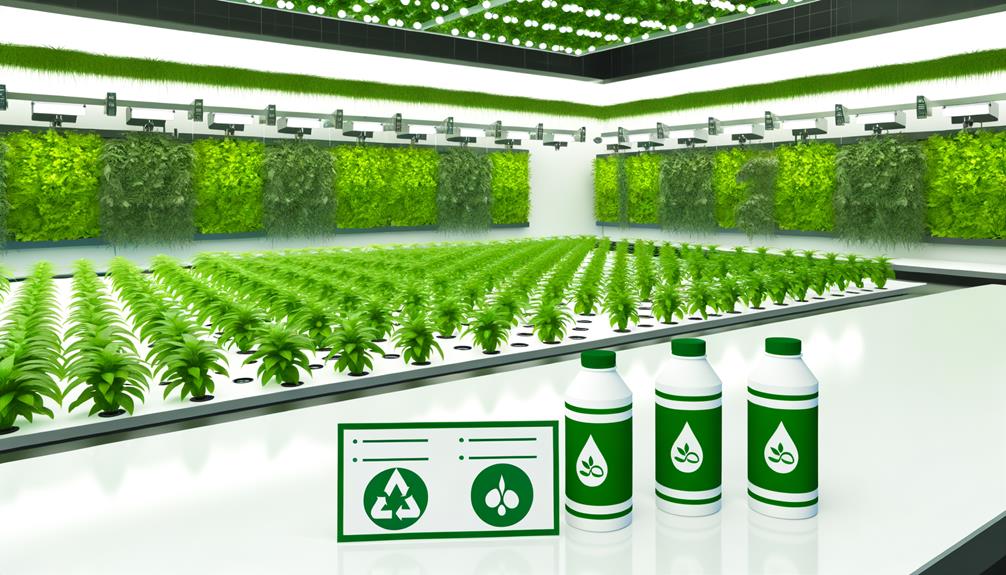
Organic certification standards for hydroponic nutrients encompass stringent criteria, including permissible inputs and sustainable practices.
Compliance with these standards requires thorough documentation and periodic audits by accredited certifying bodies.
Verification processes ascertain that nutrient formulations align with organic regulatory frameworks, thereby guaranteeing product integrity and consumer trust.
Certification Criteria Overview
Certification criteria for organic hydroponic nutrients encompass strict guidelines set forth by various regulatory bodies to confirm compliance with organic farming standards.
These criteria guarantee that the nutrients used in hydroponic systems adhere to principles of sustainability, environmental stewardship, and chemical-free cultivation.
Key factors considered in the certification process include:
- Source of Nutrients: Nutrients must originate from natural, non-synthetic sources.
- Substance Prohibitions: Certain synthetic additives and contaminants are strictly forbidden.
These stringent requirements are designed to maintain the integrity of organic labeling, confirming consumers receive products that align with organic agricultural principles.
Understanding these criteria is essential for hydroponic growers seeking organic certification for their nutrient solutions.
Compliance and Verification
Ensuring compliance with organic certification standards necessitates rigorous verification processes to authenticate that hydroponic nutrients meet established organic farming guidelines.
These processes involve detailed documentation and transparent traceability of all nutrient inputs. Certifying bodies, such as the USDA or OMRI, mandate that hydroponic nutrient formulations be scrutinized for prohibited substances, synthetic additives, and adherence to organic integrity.
Laboratory testing and audit trails are essential components of this verification, ensuring that products conform to National Organic Program (NOP) standards. Additionally, periodic inspections and third-party evaluations play an imperative role in maintaining continued compliance.
This multi-faceted approach guarantees that General Hydroponics nutrients, if labeled organic, satisfy stringent criteria, thereby upholding consumer trust and regulatory standards.
Production Methods Examined
The production methods of General Hydroponics nutrients involve a meticulous synthesis process that guarantees ideal nutrient balance and bioavailability for hydroponic systems.
These methods employ advanced chemical engineering techniques to ensure nutrient solutions are both stable and effective.
The production process can be summarized through the following key steps:
- Component Selection: High-grade raw materials are chosen to guarantee purity and consistency.
- Precise Formulation: Nutrient ratios are calculated with exact precision to meet specific plant needs.
Each of these steps is integral to producing nutrient solutions that support superior plant growth while maintaining the integrity of the hydroponic environment.
Synthetic Vs. Organic Nutrients

While the production methods of General Hydroponics nutrients guarantee ideal nutrient solutions, the distinction between synthetic and organic nutrients remains a vital consideration for hydroponic growers. Organic options are derived from natural sources, such as compost extracts or fish emulsions, offering a more sustainable approach to plant nutrition. Choosing an organic nutrient solution for hydroponics can promote beneficial microbial activity, which aids in nutrient absorption and overall plant health. However, growers must ensure proper filtration and oxygenation to prevent clogging and maintain system efficiency.
Synthetic nutrients are chemically formulated to provide precise nutrient ratios, ensuring consistent availability and uptake. These compounds are highly soluble, facilitating immediate absorption by plants.
Conversely, organic nutrients are derived from natural sources such as compost, bone meal, and fish emulsion. They release nutrients more slowly through microbial activity, promoting a more gradual nutrient availability.
Organic options often enhance soil microbiome health, though their nutrient composition can be less predictable.
Understanding these differences is essential for optimizing plant growth and meeting specific cultivation goals within hydroponic systems.
Impact on Plant Health
Evaluating the impact of nutrient types on plant health reveals significant differences in growth patterns, stress tolerance, and overall vigor. Research indicates that the composition of hydroponic nutrient solutions, whether synthetic or organic, directly influences physiological responses in plants.
Key observations include:
- Growth Rate: Plants fed with synthetic nutrients often exhibit accelerated growth due to precise nutrient availability.
- Stress Tolerance: Organic nutrients can enhance a plant’s resistance to biotic and abiotic stressors through improved soil microbiome interactions.
These findings underscore the necessity of selecting appropriate nutrient formulations tailored to specific cultivation goals and environmental conditions.
Environmental Considerations
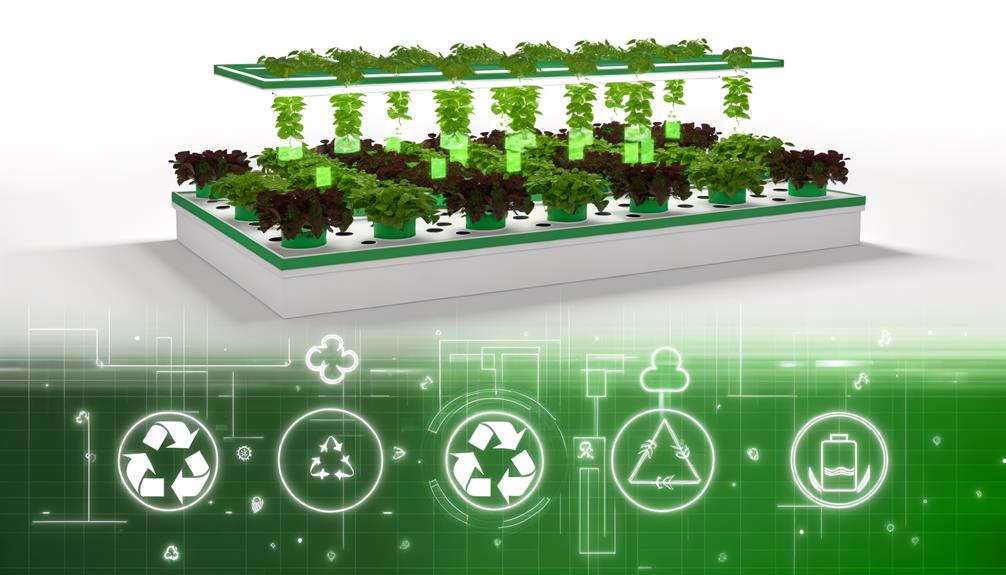
Environmental considerations for hydroponic nutrient solutions encompass factors such as ecological impact, resource utilization, and sustainability practices.
Hydroponics often rely on synthetic nutrients that can potentially lead to nutrient runoff, contributing to eutrophication in water bodies.
Resource utilization involves the efficiency of water and energy; hydroponic systems typically consume less water compared to soil-based agriculture, but the production and transportation of synthetic nutrients can offset these gains.
Sustainability practices in hydroponics include the adoption of closed-loop systems to recycle nutrients and minimize waste.
Evaluating the carbon footprint of nutrient production, packaging, and distribution is essential for a thorough environmental impact analysis.
These factors collectively inform the environmental stewardship of hydroponic nutrient solutions.
Making an Informed Choice
Making an informed choice in selecting hydroponic nutrients necessitates a thorough understanding of nutrient composition, bioavailability, and their environmental ramifications.
Evaluating whether General Hydroponics nutrients align with organic standards involves examining their chemical makeup and origin. Key considerations include:
- Nutrient Source: Determine if the nutrients are derived from synthetic or natural sources, impacting organic certification.
- Bioavailability: Assess how readily plants can uptake these nutrients, influencing growth efficiency and yield.
These factors guarantee that the selected hydroponic nutrients not only meet the desired organic criteria but also contribute to sustainable agricultural practices and optimized plant health.
Conclusion
The analysis reveals that General Hydroponics nutrients primarily consist of synthetic compounds, lacking organic certification.
Organic nutrients must adhere to stringent standards, prioritizing natural sources.
Comparative studies indicate synthetic nutrients can match or exceed organic nutrients in promoting plant health.
However, environmental impacts favor organic options due to reduced chemical runoff.
As a result, selecting hydroponic nutrients requires evaluating certification standards, environmental implications, and plant health outcomes, ensuring a balanced, informed choice.


